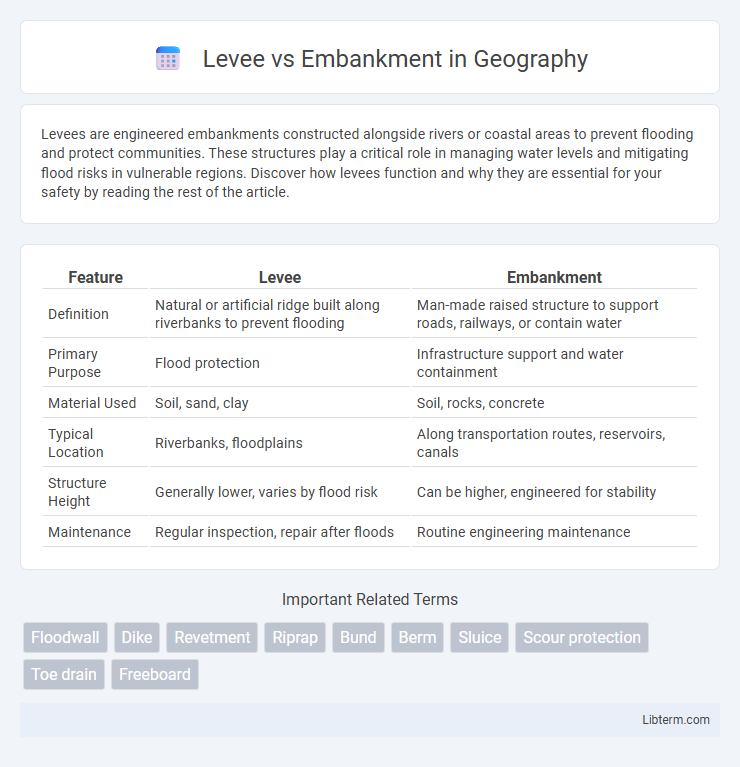Levees are engineered embankments constructed alongside rivers or coastal areas to prevent flooding and protect communities. These structures play a critical role in managing water levels and mitigating flood risks in vulnerable regions. Discover how levees function and why they are essential for your safety by reading the rest of the article.
Table of Comparison
| Feature | Levee | Embankment |
|---|---|---|
| Definition | Natural or artificial ridge built along riverbanks to prevent flooding | Man-made raised structure to support roads, railways, or contain water |
| Primary Purpose | Flood protection | Infrastructure support and water containment |
| Material Used | Soil, sand, clay | Soil, rocks, concrete |
| Typical Location | Riverbanks, floodplains | Along transportation routes, reservoirs, canals |
| Structure Height | Generally lower, varies by flood risk | Can be higher, engineered for stability |
| Maintenance | Regular inspection, repair after floods | Routine engineering maintenance |
Introduction to Levee and Embankment
Levees and embankments are engineered structures designed to prevent flooding by containing or redirecting water flow in rivers, lakes, or coastal areas. Levees are typically earthen barriers constructed parallel to water bodies, featuring compacted soil layers to provide resistance against erosion and overtopping. Embankments, often broader and more varied in construction materials, serve as raised grounds to support infrastructure, regulate water, or act as flood defenses by stabilizing adjacent land elevations.
Definitions: Levee vs Embankment
A levee is a natural or artificial wall designed to prevent river water from flooding adjacent land, primarily constructed along riverbanks to control water flow. An embankment refers to a raised structure, often made of soil or earth, built to support roads, railways, or to hold back water, serving broader functions beyond flood protection. While levees specifically focus on flood defense, embankments encompass a variety of structural uses including transportation and land reclamation.
Key Differences Between Levee and Embankment
Levees are specifically engineered structures designed to prevent river or coastal flooding by acting as barriers, whereas embankments serve broader purposes such as supporting roads, railways, or retaining soil in construction projects. Levees typically consist of earth or concrete and are positioned along water bodies to control water flow, while embankments are raised mounds of soil or rock designed for stability and load-bearing. The primary distinction lies in their function: levees focus on flood protection, embankments prioritize structural support and land elevation.
Purposes and Functions
Levees and embankments serve crucial functions in flood control and land protection, with levees primarily designed to prevent river water from inundating adjacent land by acting as elevated barriers along riverbanks. Embankments, often broader and constructed from earth or other materials, are built to support transportation infrastructure or contain water bodies, controlling erosion and stabilizing terrain. Both structures are essential in managing water flow, protecting human settlements, and maintaining ecological balance in flood-prone areas.
Types of Levees and Embankments
Levees are typically categorized into three types: floodwall levees, earthen levees, and sheet pile levees, each designed to prevent river or tidal flooding. Embankments include types such as gravity embankments, combined embankments, and slope embankments, which function primarily as physical barriers to contain or redirect water flow. Both structures vary in materials and construction methods, with levees often using compacted earth or masonry, and embankments relying on engineered fills and natural soil profiles.
Construction Materials and Techniques
Levees are typically constructed using compacted earth, often reinforced with clay cores to improve impermeability, and may include layers of sand, gravel, or rock to enhance stability and drainage. Embankments involve a broader variety of materials such as soil, rockfill, and sometimes concrete or geotextiles, designed to support infrastructure like roads or railways while controlling water runoff. Construction techniques for levees emphasize hydraulic resistance and erosion control, employing methods such as vegetation planting and riprap placement, whereas embankments focus on load-bearing capacity and settlement prevention through compaction and layering strategies.
Advantages and Disadvantages
Levees provide effective flood protection by acting as raised barriers along riverbanks, but they can lead to increased flooding downstream and require regular maintenance to prevent breaches. Embankments offer versatile flood control by stabilizing slopes and managing water flow in various terrains, though they can be costly to construct and may disrupt natural habitats. Both structures play crucial roles in flood management, with levees focusing on riverbank protection and embankments supporting broader soil retention and erosion control needs.
Applications in Flood Control and Land Management
Levees and embankments serve critical roles in flood control by acting as barriers that restrain river or coastal waters, preventing inundation of adjacent lands. Levees, typically constructed along riverbanks, are designed to protect urban and agricultural areas from seasonal flooding, while embankments often support infrastructure like roads and railways by elevating them above flood-prone zones. Both structures contribute significantly to land management by enabling safe development in floodplains and preserving valuable farmland from water damage.
Maintenance and Structural Integrity
Levee maintenance demands regular inspection and repair to prevent erosion, seepage, and animal burrows, ensuring its structural integrity against floodwaters. Embankments require routine vegetation management and slope stabilization to avoid surface erosion and structural weakness, preserving their durability. Both structures rely on proactive monitoring and timely reinforcement to sustain their protective functions effectively.
Conclusion: Choosing Between Levee and Embankment
Choosing between a levee and an embankment depends on factors such as site conditions, water flow, and flood risk levels. Levees are typically preferred for high-water events due to their engineered height and strength, while embankments offer a more natural, cost-effective solution for moderate flood protection. Understanding project requirements and environmental impact helps determine the most suitable flood control structure.
Levee Infographic

 libterm.com
libterm.com